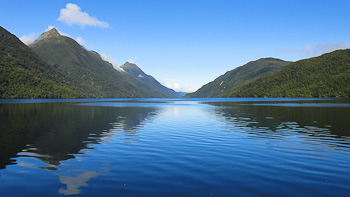
Tenaya
February
2012
Part Six
Sailing in Fiordland:
Dusky Sound & Luncheon Cove
| |
| HOME |
| About Tenaya |
| About Us |
| Latest Update |
| Logs from Current Year |
| Logs from Previous Years |
| Katie's View |
| Route Map |
| Links |
| Contact Us |
![]()
February 23, 2012
Luncheon Cove: 45 46'.18S 166 32'.32E
Although the weather has been very nice during our time in Fiordland, we still choose "all weather" anchorages and those we've used are the most calm and quiet places Tenaya has ever rested. Last night the boat never budged. Granted, we had the anchor set and a sternline to shore as well as a line from midships to the island. But still, a sailboat tends to move a little.
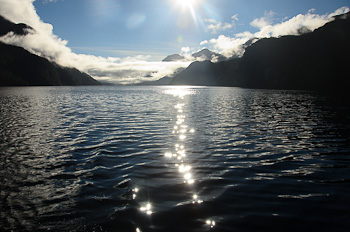
At 0900 we were on our way out the Acheron Passage to the famed and beautiful Dusky Sound. It was a glorious morning with barely a breath of wind as nebulous clouds hung low between the peaks. Again, except for some Fiordland crested penguins, we were alone as we slowly made our way through the steep-sided channel.

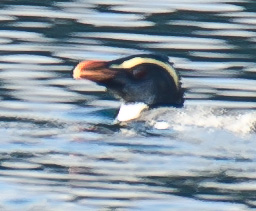
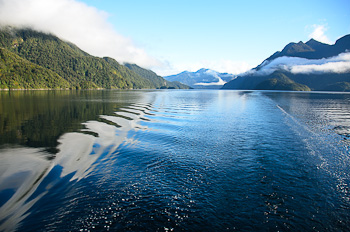
At the end of the Acheron Passage we turned left to head up Dusky Sound before rounding Long Island for a pleasant journey down towards the entrance via the narrow Cook Channel.
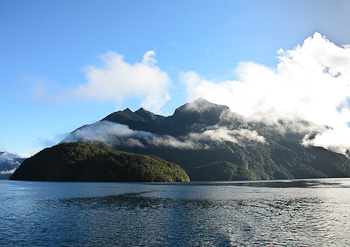
We were not expecting what we saw next. The not-large-compared-to-most-but-still-enormous cruise ship Volendam, which we'd seen in Milford Sound, was making its way up Dusky Sound from the sea. Its massive presence still dwarfed by the towering mountains on either side. Slowly the behemoth changed course and disappeared into the Acheron Passage and we were alone once again.
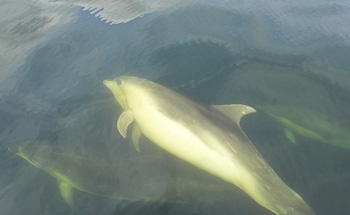
Just before we reached the gap beyond Long Island a few dolphins came for a quick visit. They sure are curious and playful creatures.

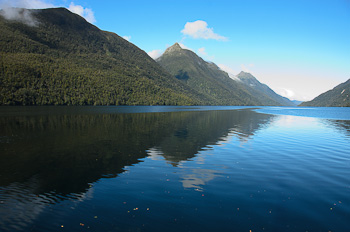
By now the sun was shining and the temperature was warm. The majectic peaks towering on each side of this narrow passage reflected beautifully on the glassy surace. Capt. Cook must have had more wind when he sailed through here so many years ago. We were happy to have an engine for our trip.

Many islands dot the entrance to Dusky Sound and we were headed for Anchor Island which has safe anchorages.
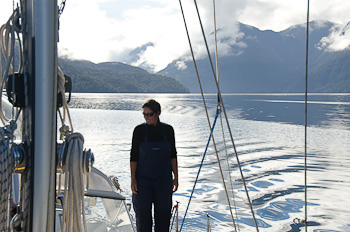
Anchor Island is predator free with no rats, mice, stoats or possums. Several species of endangered birds reside here including some of the last remaining kakapo, a portly, flightless parrot with interesting mating practices. The male digs a shallow bowl shaped spot on the ground, sits in it and calls for a mate by making a series of booms in the night. The female may walk up to 5 km to mate and then leaves to nest alone. With those mating practices, it's a wonder there are any kakapos left at all.
Several people told us not to miss Luncheon Cove where it's possible to get paua (abalone) and crayfish (spiny lobster) in shallow water. But the best part of Luncheon Cove is that there are no sandflies. Those miserable little pests left dozens of itching red sores on my ankles and hands from my time cleaning mussels on deck in Stick Cove. At times I cannot control myself and scratch with complete abandon until Jim brings out a bottle of benadryl.
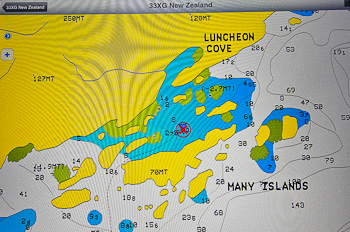
There is an all-weather anchorage at Inner Luncheon Cove and we considered going in there but the charts show it quite shallow with a lot of rocks and very enclosed. Although it is pretty, it might be somewhat claustrophobic.
We were told by Sean and Maria on Tutoko 2 that we could use the mooring in the center of Outer Luncheon Cove. We arrived to find it empty so claimed it, disregarding the message. Honestly, every New Zealander we've met has been really, really nice...
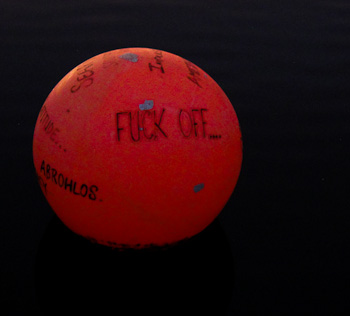
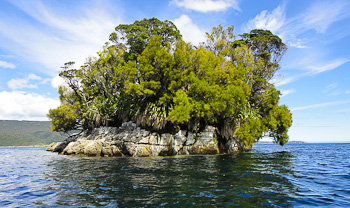
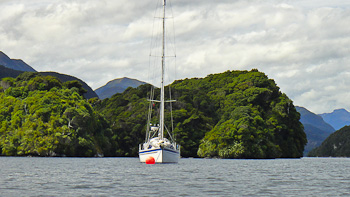
So here we sit surrounded by tiny islands inhabited by New Zealand fur seals. They growl and bark and float and frolic in the water and seemed unimpressed by our presence.
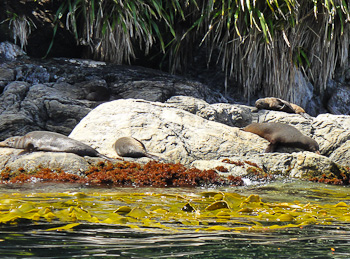
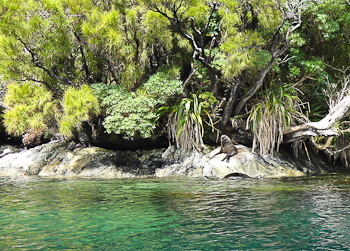

Anchor Island is the site of the first European house and wooden ship constructed in New Zealand. In November 1792 eleven men from the sealer Britannia were dropped off here and lived on the island. They were given shipbuilding materials in case the Britannia did not return to retrieve them. It did 10 months later and they left the boat nearly completed.
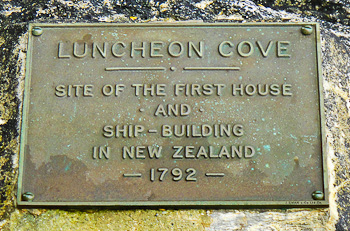
Anchor Island has a mostly muddy walking track leading through dense bush dripping with moisture and thick with the scents of damp earth to a lake with a colony of cormorants, called shags here. Several friendly South Island robins greeted us along the way. Jim almost stepped on one as it hopped around our feet while we gazed over the lake. Afraid of people, they are not.



It was low water when we paddled away from Anchor Island and threaded our way along the shores of the islands gazing down at the swaying kelp and rocks below. Paua! Lots! We hurried back to Tenaya where I pulled on my wetsuit, grabbed my mask, snorkel, booties, gloves and knife before returning to the spot.
As I tried to find the biggest paua from the kayak, Jim pointed out a rather large octopus making its way through the kelp. It's arms were as long as his, though very skinny, and it's reddish brown body was about 18 inches long. I hesitated easing over the side as I didn't fancy having one of those nearby.
This was my first time trying to get paua or abalone of any sort. Apparently you are supposed to move quickly and get the knife under the foot before the animal realizes it is in trouble and clamps down. Once I was in the water I looked down to get my bearings. One foot was standing on a nice sized one so the element of surprise was lost there.
I tried to slide my knife under another large one but that was completely unsuccessful right away. It went on that way a few more times until I eventually got it right and one slightly larger than the minimum legal size popped off very easily. Success!
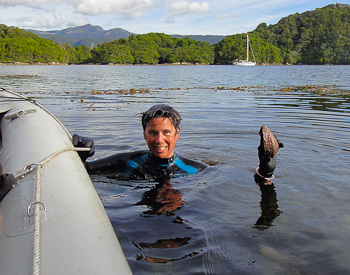
It was an active thing in the kayak, trying to attach its fleshy black foot to Jim's bony white foot. Back on the boat I pried it out of the shell, cut off the skirt, gave it a few whacks with a rubber mallet to make it flexible, chopped it up and sauteed it with butter, garlic, onions and ginger. Delicious. Wish I'd gotten two! Fortunately we'd gathered two dozen mussels so there was plenty for dinner.
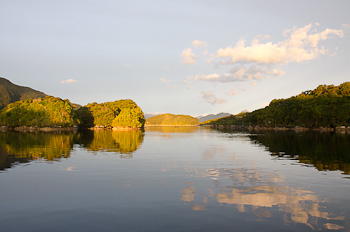
The wind is supposed to blow 24-40 knots over the next several days so we will hunker down here and wait for a good window to move further south.

Go to Dusky Sound and Luncheon Cove Part Two